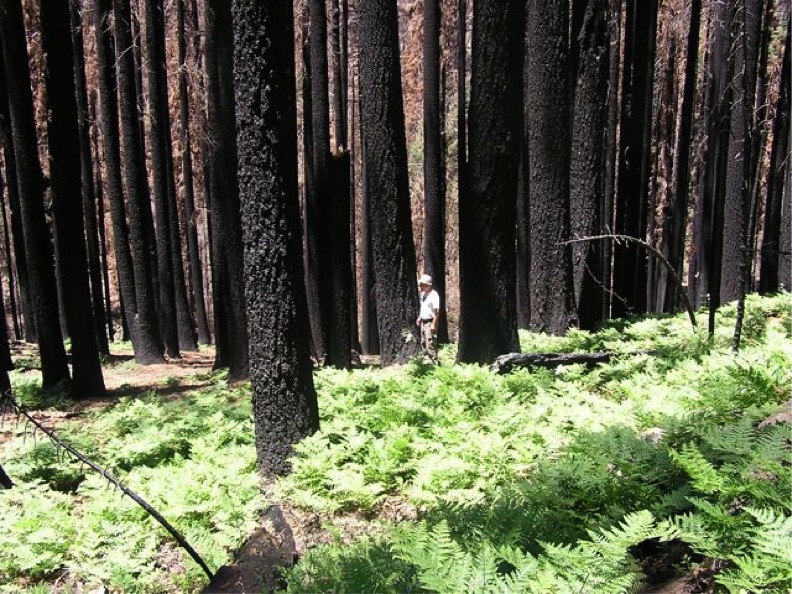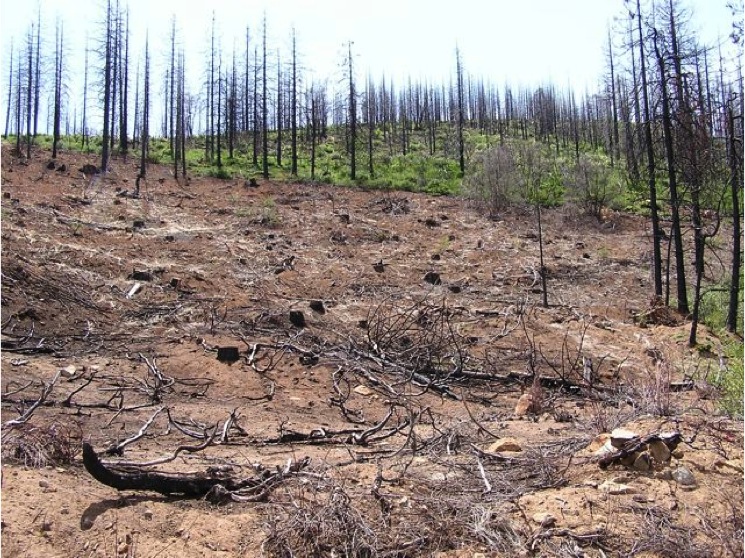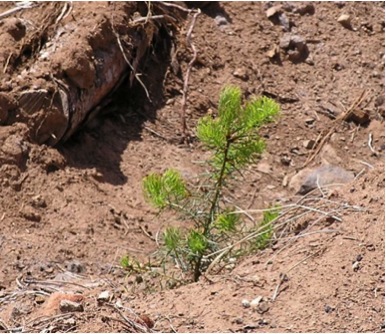

Ferns and bushes re-sprouting in the Rim Fire on USFS land would be killed back by herbicides as on the private land above.
Most people would agree that it makes sense to re-plant conifer trees in giant “holes” burned by the Rim Fire, where 100-year-old stands of conifers were so intensely roasted that cones and seeds were incinerated. Without the planting of young conifer seedlings, many areas (such as top left) that were previously habitat for goshawks, owls, songbirds, and martens may not be conifer forest again for a century or longer. Many historic forest areas will convert to brush fields similar to the thousands of acres of forest that converted to brush after the Complex wildfires of 1987.
It is not surprising that CSERC found strong consensus support for reforestation in the Rim Fire from loggers, politicians, business leaders, wildlife advocates, water agencies, and members of the general public who simply want a forest to re-grow. But “the devil is in the details.”
Despite all of the recent science proving that historic forests were diverse with scattered trees, clumps, and openings, Stanislaus Forest officials proposed dense reforestation plantings, including areas with evenly spaced trees in rows. Except for gaps around oaks, the end result would be highly stocked tree plantations. But the greatest controversy was ignited by the Stanislaus Forest plan to spray herbicides across 26,000 acres wherever seedlings were planted. Herbicides could be sprayed on every acre up to four times. Then to deal with invasive weeds, the agency proposed also spraying 5,000 acres multiple times. Overall, a total of more than 100,000 acres-worth of chemical treatment could be approved across roughly 30,000 acres.
But the greatest controversy was ignited by the Stanislaus Forest plan to spray herbicides across 26,000 acres wherever seedlings were planted. Herbicides could be sprayed on every acre up to four times. Then to deal with invasive weeds, the agency proposed also spraying 5,000 acres multiple times. Overall, a total of more than 100,000 acres-worth of chemical treatment could be approved across roughly 30,000 acres.
CSERC led local resistance to the chemical-dependent plan, pointing out that glyphosate (the proposed herbicide) has been identified by the World Health Organization as a probable cancer-causing chemical. We also listed our even stronger concern that herbicides definitely work, so a large percentage of the diverse plants that are now sprouting across the 40 square miles to be treated would end up being killed by the sprays. At reforestation workshops and in written comments, CSERC staff urged that conifer planting be done in a more natural mosaic of scattered trees, clumps, and openings, and that herbicides only be used where no feasible alternative existed to ensure seedling survival.
In July the USFS held its fifth reforestation workshop, and the range of participants reflected the strong diversity of opinions. Retired agency foresters promoted highly stocked plantations treated multiple times by herbicsides to kill competing plants. CSERC and others advocated for planting scattered conifer seedlings in between clumps of existing bushes and oaks so as to reduce herbicide need and quickly establish the “individual trees, clumps, and openings” approach that would reduce fire risk. This fall the Forest Service plans to release its draft EIS and its range of alternatives for “where” and “how” to reforest. CSERC aims to continue to work for a low controversy, balanced plan.

